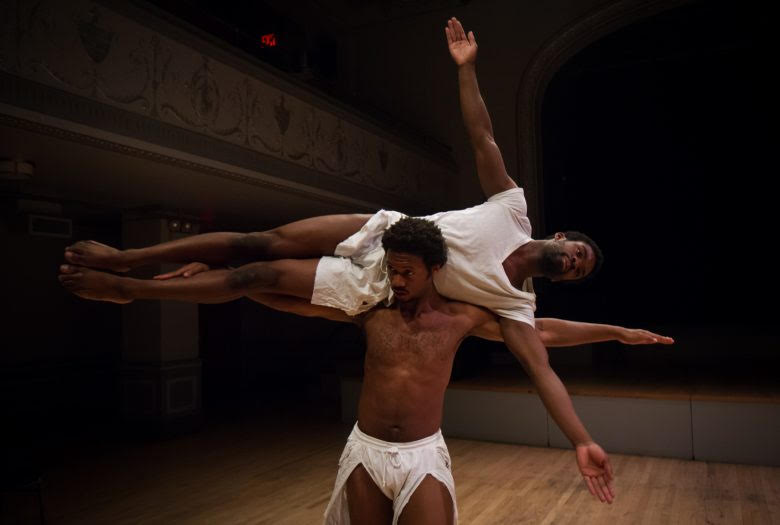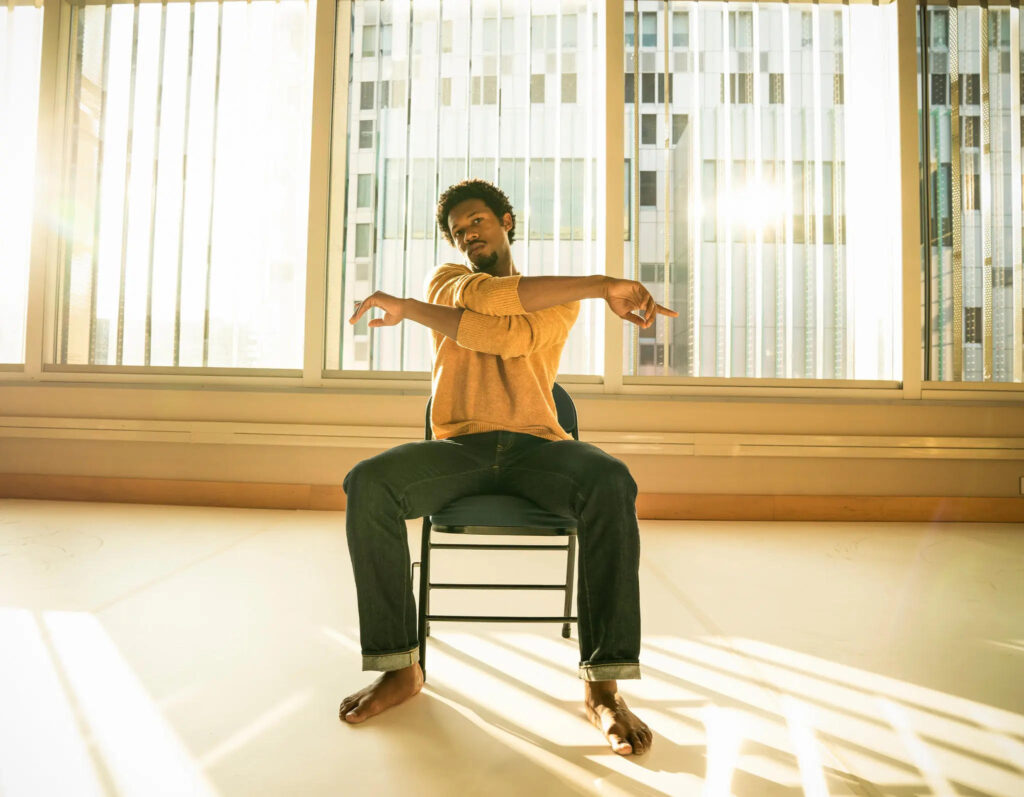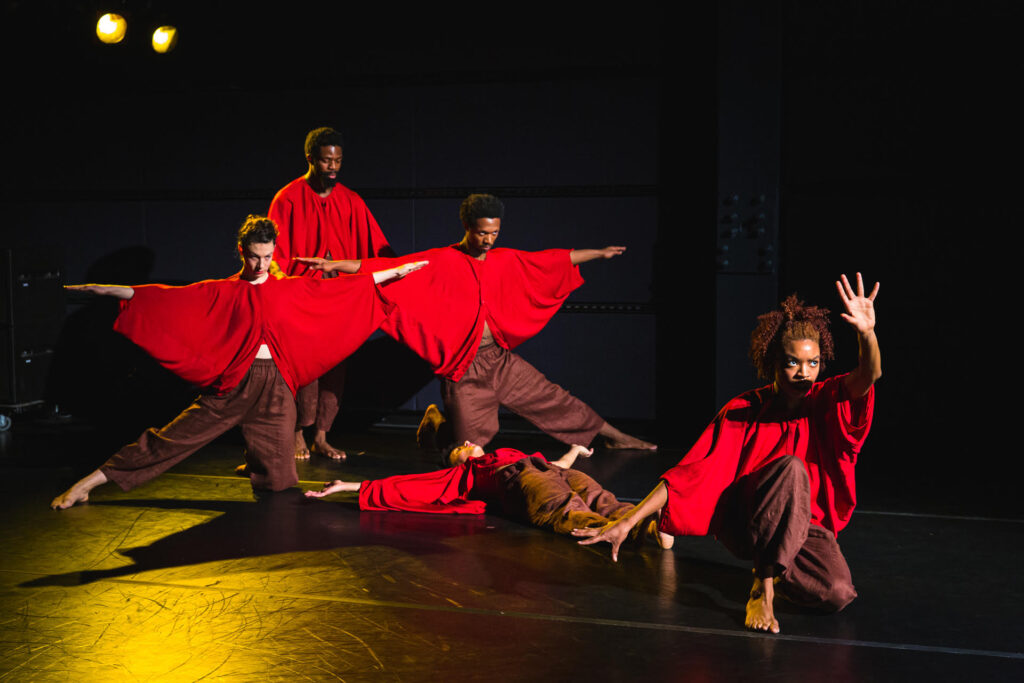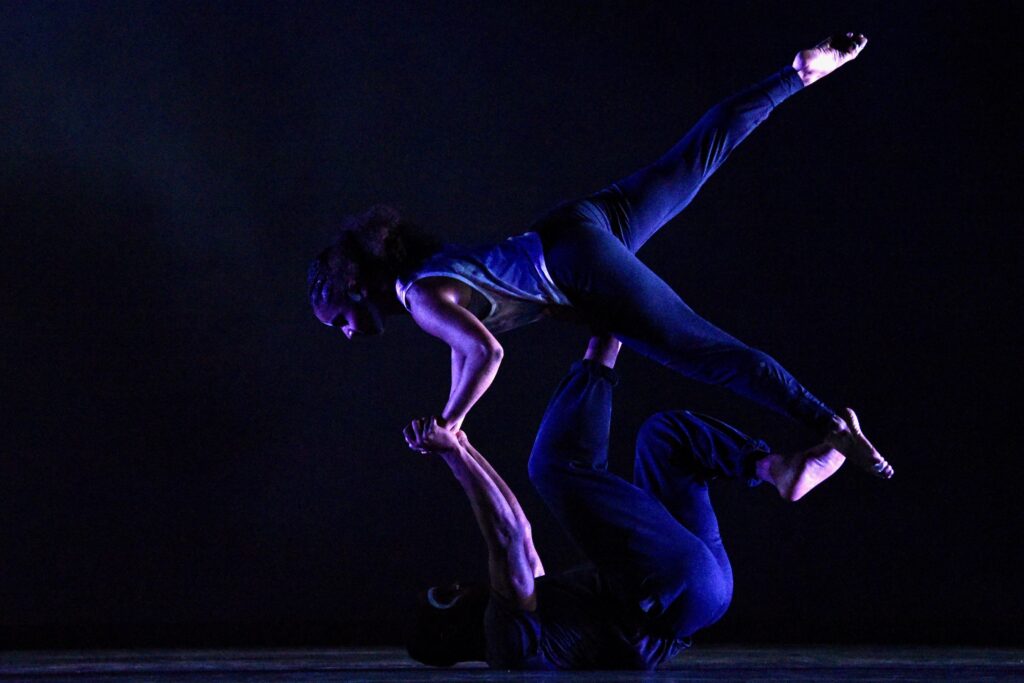Choreographing the Spirit: Kyle Marshall, Religion, and Race on the Dance Stage
A profile of how acclaimed choreographer Kyle Marshall infuses his performances with religious motifs

(Image source: Kyle Marshall Choreography. Photo by David Gonsier)
In the United States, few modern dance choreographers have created memorable meditations on religion since Alvin Ailey’s masterwork Revelations, which premiered in 1960. But Kyle Marshall, an award-winning New York-based choreographer, is currently exploring how the dancing body, and especially the Black dancing body, becomes a vehicle for spiritual transcendence.
Writing for The New York Times in 2019, dance critic Siobhan Burke remarked that Marshall demonstrates “a choreographic voice like no one else’s,” and added that he is a “compelling, sensitive dancer.” In The Dance Enthusiast, Deirdre Towers called Marshall’s choreography “a treasure.” In an interview with The New York Times, Marshall shared how he “dances out his feelings about race and religion.” For Marshall, dance can make religious ecstasy, divine union, and spiritual community visible. In some of his works, Marshall examines the politics of religion and incorporates religious motifs from his African diasporic ancestry. In doing so, he shows how dance functions as a powerful point of entry into the sacred and the place of religion in Black American life.
Early Encounters with the Sacred
As a young child growing up in the 1990s, Marshall danced at home and improvised his own choreography. Around age 5, he began formal training in ballet, tap, and jazz. In his youth, Marshall also participated in liturgical dance, a form of dance that is an act of worship in some church communities. As a child he danced at Fresh Anointing Christian Center in Philadelphia, and then as a teenager he continued liturgical dance at the First Baptist Church of Lincoln Gardens in Somerset, New Jersey. Marshall recounts that this exposure to liturgical dance “informed my understanding that my body could be used for praise, for worship, and to celebrate.”
Years later, Marshall went on to study modern dance at Rutgers University. He also began to dance professionally for acclaimed choreographers Doug Elkins, Trisha Brown, Tiffany Mills, and others. In college, Marshall started to experiment with choreography. In 2009, while still at Rutgers, he made a piece called The Wind Blew the Salt of the Earth, set to the music of Estonian composer Arvo Pärt. For this dance, Marshall was inspired by the image of the pillar of salt from the Sodom and Gomorrah story. Marshall recalls devising several bowing and falling movements, as well as evoking a sense of an “Other,” or some mysterious presence hovering above the dancers. “That was the first time I was thinking about something like spirit, God, or something larger that way with my work,” Marshall reminisced to me.

(Image: Kyle Marshall. Image source: Dana Scruggs for the New York Times)
Religion had always been a powerful force in Marshall’s life. He attended a Baptist church every Sunday as a child and participated in Bible study. All of his grandparents were religious, and his paternal grandfather was a Pentecostal minister. “I have distinct memories of my grandmother shouting, and people catching the spirit,” Marshall recollects. Those early encounters with the sacred would inform Marshall’s choreography for years to come.
Methods of an Artist-Scholar
In 2014, Marshall started his own professional dance company, Kyle Marshall Choreography. Marshall is both the resident choreographer and a dancer in his company. He takes a decidedly intellectual approach to choreography, embarking upon serious scholarly research in preparation for his works, thereby imbuing dance-making with intellectual insights. His longstanding interest in religion has informed much of his professional work. As Marshall explains, “I think that religion is a framework for faith and belief. And these frameworks are human-made. They are the human logic of understanding and creating a system with which we can organize our faith and beliefs. And that manifests itself in Christianity, Buddhism, Hinduism, and all of the religions.”
While many of Marshall’s works address spirituality in uplifting ways, he has also explored religion as a form of control and domination. In his 2019 work A.D., commissioned by the Brooklyn Academy of Music, Marshall examines Christianity’s influence on the body. The dance features an electronic sound-sculpting instrument built by Cal Fish, which allows the voices of the performers to be amplified and recorded in real-time and played alongside a pre-recorded musical score.

(Photo from AD. Image source: Kyle Marshall Choreography)
Marshall explained to The New York Times that “I like to think that in building A.D. the audience can become a congregation. It can become a space where people can reflect. So it’s not just audience-performer. I think this work is calling for a different kind of attention.”
In rehearsals for A.D., Marshall integrated excerpts from the Bible. In the studio, Marshall and his dancers would speak the text. Then they improvised around it, experimenting with different movement styles and patterns. The dancers also discussed biblical passages, indicating whether or not they related to the words. “It definitely got heated,” Marshall remembers.
When preparing A.D., Marshall became interested in the Bible’s complex authorship. “These spiritual texts were then edited by mostly men and then put together as a holy book. And I found it really compelling what was there, what was left out, who decided, and when,” he told me. A.D. explores religion as a vehicle of social control.
As he studied the Bible more closely, Marshall became interested in apocryphal texts not included in the Protestant Bible. He began to read Gnostic texts, stories written in the early centuries of Christianity that often have a more radical take on Jesus and his disciples, including Judas and Mary Magdalene. At this time, Marshall studied religion scholar Elaine Pagels’ breakthrough book, The Gnostic Gospels. “I read Pagels’ work and didn’t realize how radical the Gnostics were for their time,” says Marshall. “And that was really compelling to me. How does a group that was once radical become a domineering group? How did the Roman Empire become the Catholic Church? All of these things really started to open me up a bit.”
Beyond textual evidence, A.D. and many of Marshall’s other works also derive inspiration from religious iconography. European Christian art often depicts angels as white and demons as black. Using primarily Black and brown dancers, Marshall challenges these paradigms to showcase the sanctity of blackness.
Marshall’s study of religious art seems to have enhanced his own dancing and that of his company members, as critics have remarked. Writing for The Dance Enthusiast, Deirdre Towers explains that in A.D. Marshall is “laconic, measured, he dances with the pacing of a pensive man. He walks tall, knowing that stance is a statement in itself. His dancers jump with a surprising lightness and stretch into arabesques with feline elasticity.” Like the saints and martyrs of antiquity, Marshall and his dancers are both strong and ethereal.
Revealing the Spirit: Joan (2021)
Marshall often engages religious themes to show how the past is relevant to the present. This is especially true in Joan (2021), which is based on the life of Saint Joan of Arc (d. 1431). Marshall fell in love with a musical score by Julius Eastman (d. 1990) called The Holy Presence of Joan d’ Arc, and he proceeded to choreograph a duet in 2019. The Isabella Stewart Gardner Museum in Boston commissioned this work, and it featured live music performed by Castle of Our Skins, a Black-led chamber ensemble.
In 2020, the New World Symphony, based in Miami, commissioned a new version of the Joan of Arc piece. Marshall used this opportunity to expand the work into a quartet. At this time, he also received support from the prestigious Center for Ballet and the Arts at New York University, where he was a residential artist-scholar during the 2021-2022 academic year. Marshall’s dance company premiered Joan in New Brunswick in October 2021, and a week later the dancers performed the work in Miami.
Marshall was particularly interested in depicting Joan of Arc’s spirituality and triumph. Joan was a medieval French peasant who supposedly had visions of the saints. The saints prophesied that Joan would lead the king’s army to victory against the English, which she did. Joan was later captured by enemy forces, put on trial, and burned at the stake. She is now one of the patron saints of France and a feminist and queer icon. (Incidentally, documents from Joan’s trial mention dance, as they accuse Joan of engaging in superstitious, heretical activity that included dancing and singing around a fairy tree in her home village). Marshall saw in Joan an ideal medium for portraying revolution and resistance. “I found the story of a young woman determined to lead her people to victory to be very empowering. I was inspired by this story of victory over tyranny. And I was also interested in the spiritual element that involves the saints who visit her,” says Marshall.
Marshall’s representation of Joan of Arc also has a present-day and intercultural twist, as he integrates medieval French history with modern Black identity. As a Black man who works with primarily Black and brown artists, Marshall wanted the work to draw from his Black experience. “I am interested in how Black art-making is a wide spectrum of experience,” explains Marshall. When making Joan, Marshall reflected on his Jamaican heritage, and through his ensuing research, he discovered the history of the Maroons. The Maroons were enslaved Africans from eighteenth-century Jamaica who managed to escape their British enslavers by relocating to the mountains. They led a campaign against the British and won their freedom. “I found that story really empowering,” says Marshall. “We don’t always learn about liberation struggles in our history. We know that slavery happened but we don’t always know that people resisted.” The Maroons also had a female leader named Queen Nanny (d. 1733), which for Marshall became another point of connection with the Joan of Arc story.

(Image from Joan. Image source: Kyle Marshall Choreography)
The spiritual component of Joan’s story guided Marshall’s choreography. He wanted the dancers to embody aspects of the saints. In Joan, Marshall uses the stage in symbolic ways. To convey spiritual presence and divine-human communication, the dancers use the extreme sides of the stage, thus conjuring images of messengers and connections between large distances. Near the end of the piece, Joan stands in the center of the saintly figures, displaying strong, defiant port de bras (arms movements) and a warrior-like stance. Joan leaves us with an arresting tableau of the spirit’s triumph in the face of adversity.
In a review of Joan in the New World Symphony News, Marci Falvey elaborates upon Marshall’s evocative choreography and musicality: “vigorous gestures and movements appeared to express oppression and conflict, with quieter moments suggesting her spiritual intimacy with the three saints. The muscular force of the dance worked well with the music, which, with its minimalist repetitive patterns provided ample space for action on stage.” As the critics suggest, Marshall integrates dance and spirituality so that the past collides with the present. Although a product of the Middle Ages, Joan, and her embodied interactions with the saints, speak to our own strategies of resistance, including struggles for racial equality.
Staging Racial Uplift
Marshall’s identity as a Black man shapes how he thinks about religion and its relationship with dance. “I think Black culture and African diasporic culture do not see the body as sinful. The body is a place of celebration,” Marshall relates. Indeed, African cultures have a long history of integrating dance and drumming into religious rituals. The practice of dancing remains important for African diasporic communities, in which dance is a potent trigger for ancestral memory. The deeply rooted connection between dance and African culture informs Marshall’s work.
In recent years, Marshall has made works that simultaneously tap into religion and race. His 2017 work Colored reflects on how the Black body is viewed in dance, engaging issues of tokenism and appropriation. White audiences have been conditioned to see Black dancers as either highly virtuosic or hypersexualized. Marshall instead depicts a wider spectrum of blackness. The work suggests how central the Black Church is to the African American experience. Colored includes a section called “Gospel,” which uses an original piece of music by the Jamaican Pentecostal Pastor T.L. Barrett entitled “Father I Stretch My Hand.”
Commenting on Colored, Tresca Weinstein writes in The San Francisco Chronicle that Marshall plays with “preconceptions and [racial] stereotypes to create something wholly unexpected and unpredictable.” New York Times dance critic Siobhan Burke reflects on the complex constitution of Colored: “twists and contradictions take physical shape in the movement itself — its swerves from brashly sexy to subdued, from ecstatic to vigilant. . . . As if taking a collective breath, the dancers begin in a circle, holding hands and looking down.” Burke later recalled how Colored made “an instant, indelible impact” on viewers. Marshall’s movement draws from the vocabulary of modern dance, yet also evokes timeless and sacred forms, notably the circular formation. In doing so, he portrays blackness as having rich ancestral roots and highlights how diasporic communities engage in protest and change.
In 2018, Marshall took a different approach to religion and race with his piece King. Harlem Stage commissioned Marshall to create a solo dance to commemorate the 50th anniversary of Dr. Martin Luther King, Jr’s death. Instead of a traditional musical score, Marshall employed a sound score that excerpted 7 minutes of King’s final speech, “I’ve Been to the Mountain Top.” This work caused Marshall to circle back to his fascination with religion. “I was thinking about the politics of religion, faith, and King. He was in a moral conversation and was trying to shift the moral imperative of Americans, and I found that very compelling,” Marshall remembers.
Marshall’s most recent exploration of blackness and spirituality is Rise, which premiered at The Shed in New York City in 2021. Rise exhibits how dance fosters interpersonal connections that facilitate spiritual growth. Writing for the Broad Street Review, Melissa Strong explains how Rise “affirms the power of shared humanity and the sacredness of gathering with others.” In her New York Times review, chief dance critic Gia Kourlas writes how Rise exudes “a sense of elation, of wonder.”
Interestingly, Marshall found inspiration for this work in nightclub culture and house music. Marshall believes that club dancing generates a kind of collective energy that connects us spiritually and generates a feeling of transcendence. Marshall also notes that DJ Frankie Knuckles (d. 2014), the originator of house music, said that this kind of music is “church for the dispossessed.”
According to Marshall, club dancing is especially meaningful for marginalized groups. “Having that space for Black, brown, and queer folks to also have a spiritual transcendence is necessary. We all want to feel that we are connected to something larger than ourselves, or that there is something supporting us,” he says. In this way, gathering in a nightclub constitutes a kind of ritual or sacred event.
The religious aspect of nightclubbing forms a direct connection with the history of the Black Church. As Marshall explains, “for Black folks, the Church was not just a spiritual experience, it was also a place they could gather, talk, get the news of the day, and exchange resources. My grandparents going to church was not just about them having a religious space but a community space.” When choreographing Rise, Marshall meditated on footwork, and he saw similarities between contemporary clubbing and the historical shout traditions of the Black Church, that is, spiritual shouting to Gospel music common in Pentecostalism. He even included a section in the performance inspired by the Ring Shout. Originating with enslaved Africans, the Ring Shout was an expression of spirituality that involved collective dance and music. Rise underscores the primacy of the body in human experience. “That elementalness is a grounding root for us,” says Marshall. “So, I think that already lends itself to dance being a direct connection to spirituality. I am using my body as a receptacle for something greater.”
In his future choreographic projects, Marshall envisions new explorations of religion and spirituality. Currently, he is devising a piece about Alice Coltrane (d. 2007), as well as a piece on Rock and Roll, which will be a comparison between the sacred and the profane. Jazz music is now inspiring Marshall to explore further themes of transcendence.
Highlighting the world of the spirit, Marshall believes his work reveals some of the quintessential aspects of humanity. “I think it’s the reason why we’re here,” Marshall reflects. “I think it’s the reason why we dance. The spirit is not just found in organized religion. Our bodies can be vessels of divinity.”
Kathryn Dickason (NYU alumna 2008) is a Public Relations Specialist at Simmons University in Boston. She has published numerous articles on religion, dance, and medieval European history, as well as a book entitled Ringleaders of Redemption: How Medieval Dance Became Sacred (Oxford University Press, 2021).